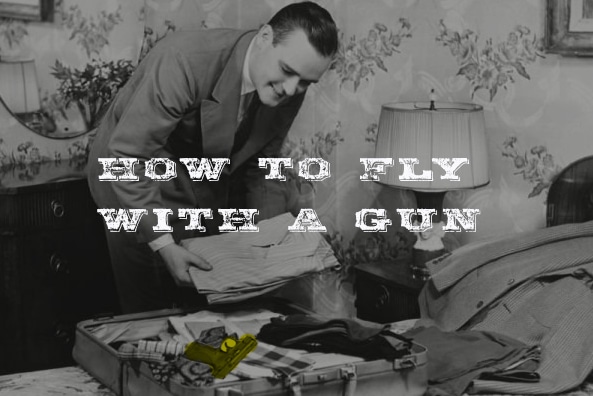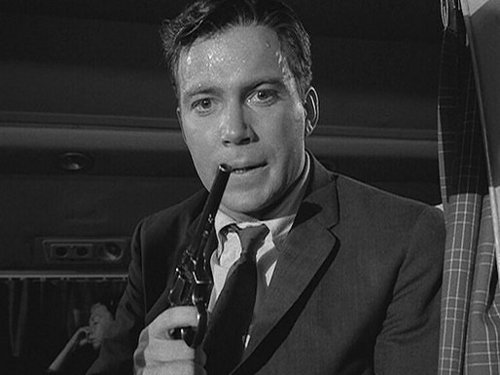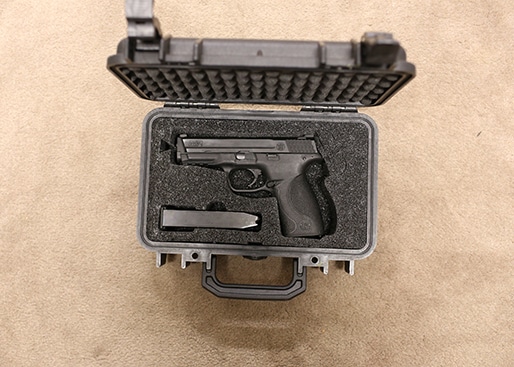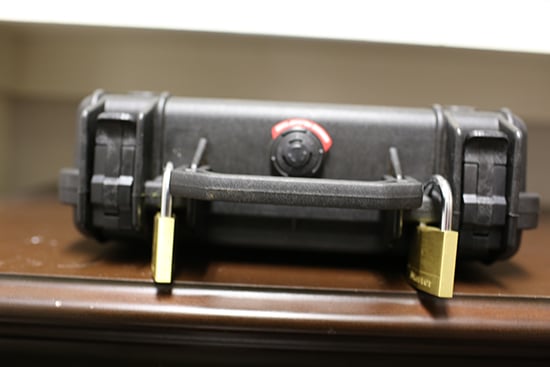
Last month I flew down to Austin to spend the weekend with the fine folks from Atomic Athlete for their Vanguard event. The Vanguard was basically 36 hours of man skills — we learned how to humanely slaughter rabbits and chickens, land navigation, and even some self-defense techniques from Tim Kennedy. It was awesome. I’ll be doing a full write-up on it soon, so stay tuned for that.
One segment of the event was a firearms class, and we needed to bring our own pistol and ammo to participate in it. Because I was flying, I would have to pack my gun for the trip. Having endured, along with my fellow Americans, thirteen years of taking off our shoes, putting our tiny toiletries in see-through baggies, and getting patted down by TSA agents, I figured flying with an actual, honest-to-goodness weapon would be a nightmare fraught with all sorts of bureaucratic, red tape rigmarole.
As it turned out, except for a small mishap, flying with a gun is surprisingly easy. Today I’ll share my experience and what I learned from it, in case any of you find yourself needing to travel with firearms and ammunition.
How to Pack Your Gun for Flying
TSA regulations require that your gun be packed in a hard-sided container that’s locked. You’ll then place that container in your checked luggage. If you can’t bring pocketknives on the plane, it’s a no-brainer that you can’t bring a gun in your carry-on bag either. That may not have always been the case though; I always thought it was funny that William Shatner had a pistol on him in that Twilight Zone episode where he sees a gremlin guy on the wing of the plane he was flying in. Any old-timers know if you could pack heat in your carry-on luggage back in the day?

That gremlin on the wing is the least of your problems, Bob. You’re about to be tackled by a federal air marshal.
Anyway, for my hard-sided, locked gun case I used this Pelican handgun carrier and these two Master locks:

My Smith & Wesson M&P 9mm in my Pelican case.

Locked with my two Master locks.
When you put your gun in your hard-sided container, it needs to be unloaded. Unloaded means nothing in the chamber; even an unchambered gun with a loaded magazine inserted in the magazine well violates the rules. The regulations suggest that you could pack a loaded magazine in the same case as your unloaded gun — it just can’t be inserted in the magazine well. To be on the safe side, I made sure all my magazines were unloaded. I also didn’t insert any of my unloaded magazines in the magazine well. In other words, I packed a completely clear gun. Paranoid? Perhaps. I just didn’t want to have to deal with any snafus.
That’s it. Same rules apply for rifles and shotguns. Put them in a hard-sided container that’s locked and make sure they’re unloaded. You even need to pack like this if you’re carrying a starter pistol or just the frame or the lower receiver of a rifle. The only exceptions are not actually bullet-firing guns: airsoft guns, paintball guns, and BB/pellet guns must be packed in your checked baggage, but don’t need to be in a special case or declared. Compressed gas cartridges for these devices aren’t allowed on airplanes at all, even in checked baggage, unless the regulator is completely removed and you have an empty, open-ended canister, which often requires a technician. TSA recommends that you ship cartridges to your destination separately.
How to Declare a Firearm at the Airport
When I arrived at Tulsa International Airport, I’ll admit I was nervous. Since I’ve seen TSA agents declare the riot act to someone who’s attempting to bring a water bottle through security, I figured they’d be even more suspicious towards a guy trying to fly with a semi-automatic pistol.
When you’re flying with a gun, you’re supposed to “declare” to the ticketing agent of the airline you’re flying with that you’re packing a gun. When I checked in for my flight, I tried to be nonchalant about it, and simply said, “I need to declare a firearm.â€

How NOT to declare a firearm.
I was expecting the ticket agent to take on a cautious and leery air, but she didn’t bat an eye – she just slapped a little card on the counter for me to fill out. On one side I was asked to put down my name, address, and phone number; on the other side I had to sign a statement affirming that the firearm in my checked bag was in a locked container and unloaded. The ticket agent put that card on top of my gun case in my checked bag. She verified that the case was indeed locked, but she didn’t ask me to open the case to show her that the gun was unloaded. She asked about my ammo, and I pointed it out to her in the bag. Then she asked if I had the keys for the locks, to which I replied in the affirmative (you’re supposed to have the keys on you and not in your checked bag). I got a friendly “Alrighty!” and she put my bag on the conveyor belt behind her and handed me my boarding passes.
As I was walking away, the ticket agent told me to wait around for 15 minutes or so in case TSA needed the keys to the locks on my gun case, in order to open and check it. She said they probably wouldn’t, but if I went through security and they decided to check my case, I’d have to come back out and go through security again. So I sat and read. Fifteen minutes later the ticketing agent said I could go.
And with that I made my first plane trip with a gun.
It was surprisingly easy and hassle free. At least on this leg of the trip…
The Tricky Part: Ammo
Like your gun, you’ll have to pack your ammo in your checked bag. Every airline has different limits on how much ammo you can pack, so you’ll need to check with the airline you’re flying with to determine how much you can bring. Southwest allows 11 pounds. I brought three boxes of fifty 9mm rounds, which was what I needed for the weekend.
According to TSA regulations, “travelers must securely pack any ammunition in fiber (such as cardboard), wood or metal boxes or other packaging specifically designed to carry small amounts of ammunition.” That’s pretty vague. Some folks take that to mean you need to pack your ammo in a special container that has individual cavities for each round you’re carrying, just the way your ammo comes in the cardboard box when you buy them. The thinking behind this is that airlines don’t want free rounds clattering around each other and possibly setting off a primer. The possibility of a primer being set off just by jostling next to another round is super remote, but when you’re flying 30,000 feet in the air, I guess it’s always better to be safe than sorry.
Well, I didn’t have any cool plastic containers with individual cavities for my rounds, so I just packed my ammo in their original boxes in a secure place in my bag. As I placed the 9mm rounds in my bag I thought, “This cardboard is pretty flimsy. There’s no way these boxes are going to make it down to Austin intact.” But I figured if the TSA said a cardboard box was safe, well, who was I to argue with that?
But sure enough, when I opened my bag in Austin, the cardboard ammo boxes had fallen apart, and I had 9mm rounds scattered all over the bottom of my bag. I made sure to thoroughly go through my bag to get every last stray round. I didn’t want that to be a problem when I was flying back to Tulsa.
After a weekend of slaughtering chickens, doing an obstacle course, and shooting guns, it was time to head home. I had made sure to fire every last round I had during the Vanguard, so I didn’t have to worry about packing my ammo for my return trip. I went to the Southwest check-in counter at Austin International Airport and declared that I had a firearm. I figured it was going to be a breeze like it had been in Tulsa — casually say “I need to declare a firearm,” sign a card, wait 15 minutes, and be on my way.
That didn’t happen.
Instead, the ticketing agent sent me to a special TSA room where a TSA agent opened up my bag and checked every single last nook and cranny of it. He even took out the bags that I had packed in my main duffle bag and checked them — Dopp kit, sleeping bag, even my pillow case. He didn’t really care about my gun case — I guess because he saw it was locked. He just put it to the side with the rest of my stuff.
Because I was carrying on a backpack with my camera gear, I packed my GORUCK backpack in my checked bag. I had used it as my gun bag when we went to the range. I was certain I had gotten every round out of it, so I wasn’t worried when the TSA agent started rummaging through it. He sifted through my stuff—pocketknife, compass, flashlight—nothing to be alarmed about. But then his hand suddenly came out of the bag and he hoisted a single 9mm round above his head like some sort of magical totem.
TSA Agent: “Bullet! Bullet!”
Damnit.
TSA Agent: “Sir, do you know you have a stray round in your backpack?”
Me: “I do now.”
TSA Agent: “You can’t carry this on the plane like this. Can you go put this back in your car?”
Me: “I rented a car… so, no.”
TSA Agent: “Do you have a friend or family member that can come up to the airport and take ownership of this round?”
Me: “Uhh…. I’m not from here, so, no.”
TSA Agent: “Well, I’m going to have to a file a report with the Austin Police.”
Me: “Well, do what you got to do.”
And off went the managing TSA agent to call Austin Police. I admittedly started to sweat a bit. Was this going to end up on my permanent record? After about 30 minutes of sitting in an airport purgatory wondering if I’d forever be on the no-fly list, a friendly Southwest ticketing agent came over and said, “Hey, I’ll be your friend for today. Don’t worry about this.” He took possession of my solitary 9mm round and the TSA let me go on through. No report was filed to the police.
I’ve always been a big fan of Southwest, but after that moment, I became a super fan.
A few weeks later I got a form letter from Southwest saying they’re aware of the incident and offering a friendly reminder to pack my ammo in a hard box next time I fly with them. A week after receiving that letter, I got a letter from the FAA saying they too are aware of the incident, reminding me of TSA regulations on flying with guns and ammo, and noting that no record of the incident had been made. That’s a relief.
So here are the takeaways from this experience:
- Flying with a firearm is easy; it’s the ammo you have to worry about.
- Every airport is different on how they handle declared firearms. Some will just have you sign a card saying your gun is unloaded and locked in a case; others are going to check every last nook and cranny of your bag after you declare your firearm.
- Check with the airline you’re flying to see how much ammo you can pack.
- Pack your cardboard boxes of ammo in a hard-sided case. Even though TSA regulations say it’s kosher, cardboard ammo boxes are no match for the beating your bags will get from luggage handlers.
- If you’re not going to pack your cardboard ammo boxes in a hard case, at least tape them up as much as possible so ammo can’t get out.
- MOST IMPORTANT TIP: Thoroughly check your bags (especially your range bag) for loose ammo. After you’ve checked once, check again.
Well, there you go. My experience flying with a gun. Not very hard. Just be careful with the ammo.
You can read the complete list of TSA regulations on flying with a firearm here.
I’d love to read your interesting stories about flying with a gun. Have any tips that most people don’t think about? Share them in the comments.


